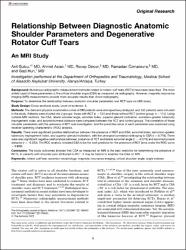| dc.contributor.author | Gülcü, Anıl | |
| dc.contributor.author | Aslan, Ahmet | |
| dc.contributor.author | Dinçer, Recep | |
| dc.contributor.author | Özmanevra, Ramadan | |
| dc.contributor.author | Huri, Gazi | |
| dc.date.accessioned | 2023-09-05T20:48:47Z | |
| dc.date.available | 2023-09-05T20:48:47Z | |
| dc.date.issued | 2022 | en_US |
| dc.identifier.uri | https://www.scopus.com/record/display.uri?eid=2-s2.0-85142344768&origin=resultslist&sort=plf-f&src=s&nlo=&nlr=&nls=&sid=20c4fe371b9b908d4f7e419f791331ff&sot=aff&sdt=cl&cluster=scofreetoread%2c%22all%22%2ct&sl=72&s=AF-ID%28%22Alanya+Alaaddin+Keykubat+University%22+60198720%29+AND+SUBJAREA%28MEDI%29&relpos=35&citeCnt=1&searchTerm= | |
| dc.identifier.uri | https://hdl.handle.net/20.500.12868/2348 | |
| dc.identifier.uri | https://journals.sagepub.com/doi/10.1177/23259671221130692 | |
| dc.description.abstract | Background: Numerous radiographic measurement methods related to rotator cuff tears (RCTs) have been described. The most widely used of these parameters is the critical shoulder angle (CSA) as measured via radiography. However, magnetic resonance imaging (MRI) measurements provide more accurate results than direct radiography. Purpose: To determine the relationship between anatomic shoulder parameters and RCT type via MRI scans. Study Design: Cross-sectional study; Level of evidence, 3. Methods: The data and physical examination notes of 389 patients were retrospectively analyzed, and 242 patients were included in the study. Patients were divided into 2 groups: those with RCT (n = 127) and those without RCT (control group; n = 115). Using suitable MRI sections, the CSA, lateral acromial angle, acromial index, superior glenoid inclination, acromion–greater tuberosity impingement index, and acromiohumeral distance were compared between the RCT and control groups. The correlation of these shoulder parameters with the presence of RCT was investigated, and the predictive value of each parameter was examined using receiver operating characteristic (ROC) analysis. Results: There were significant positive relationships between the presence of RCT and CSA, acromial index, acromion–greater tuberosity impingement index, and superior glenoid inclination, with the strongest correlation belonging to CSA (r = 0.716). There were also significant negative relationships between presence of RCT and lateral acromial angle (r = –0.510) and acromiohumeral distance (r = –0.222). The ROC analysis revealed CSA to be the best predictor for the presence of RCT (area under the ROC curve = 0.899). Conclusion: The study outcomes showed that CSA as measured on MRI is the best predictor for determining the presence of RCTs. In patients with shoulder pain attributed to RCT, it may be helpful to examine the CSA on MRI. | en_US |
| dc.language.iso | eng | en_US |
| dc.relation.isversionof | 10.1177/23259671221130692 | en_US |
| dc.rights | info:eu-repo/semantics/openAccess | en_US |
| dc.subject | Rotator cuff tear | en_US |
| dc.subject | Acromion morphology | en_US |
| dc.subject | Magnetic resonance imaging | en_US |
| dc.subject | Critical shoulder angle | en_US |
| dc.subject | Angle indexes | en_US |
| dc.title | Relationship Between Diagnostic Anatomic Shoulder Parameters and Degenerative Rotator Cuff Tears: An MRI Study | en_US |
| dc.type | article | en_US |
| dc.contributor.department | ALKÜ, Fakülteler, Tıp Fakültesi, Cerrahi Tıp Bilimleri Bölümü | en_US |
| dc.identifier.volume | 10 | en_US |
| dc.identifier.issue | 11 | en_US |
| dc.relation.journal | Orthopaedic Journal of Sports Medicine | en_US |
| dc.relation.publicationcategory | Makale - Uluslararası Hakemli Dergi - Kurum Öğretim Elemanı | en_US |


















